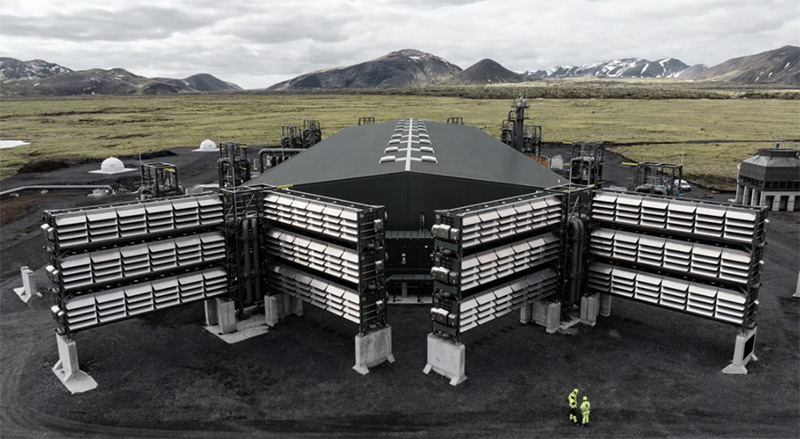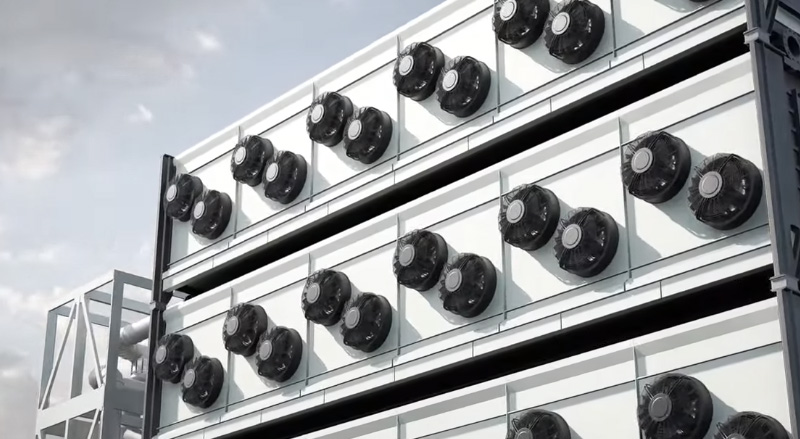
https://climeworks.com/news/climeworks-mammoth-construction-update-dec22
In a world of turmoil, trust the Sydney Morning Herald to ask the key question of the day:
Should Australia house a giant vacuum cleaner to suck carbon from the sky?
In May this year, on the flat plains of an Icelandic geothermal reserve, a gigantic vacuum cleaner designed to suck planet-warming carbon dioxide out of the sky was switched on.
The machine, called Mammoth, would not be entirely out of place on a Mad Max set….
The big machine in Iceland and will soon start pulling carbon dioxide out of the atmosphere each year and turning it into calcium carbonate rock underground.
In a world where humans make 37 billion tons of carbon dioxide annually the project will be able to remove 36,000 tons of CO2 each year, which is approximately one millionth of human annual emissions.
Cost estimates are said to be “closer to $1,000 a ton” to remove the CO2. Effectively, we’re spending 36 million dollars US to convert one millionth of human annual emissions of a fertilizing gas into limestone rock we don’t need.
Flagrant Big Government wastage doesn’t get much more pointless than this.
File this away for the history books of the future like the quest for perpetual motion machines.

https://climeworks.com/news/climeworks-mammoth-construction-update-dec22
The process is called Direct Air Capture (DAC) and supposedly the Mammoth plant achieves something equivalent to taking “8,000 cars off the road” each year, as if that was a useful thing.
The problem for the Swiss Company (Climaworks) is that the most efficient machines for capturing carbon are plants, and they’re cheap and out of patent.
Climeworks built this project in Iceland, of course, so they can use “clean” geothermal energy. But that raises the question of how much electricity it takes to turn CO2 into limestone. If we ran it off coal fired power would it ever be carbon neutral?
The Chemical Engineer explains the process
“It’s essentially a SodaStream on steroids,” says Douglas Chan, COO of Climeworks. Absorption water is injected at the top of the tower and trickles down through packing that fills the column. The water dissolves the CO2 coming up through the bottom of the tower producing a pressurised mix that is ready for injection underground through two onsite wells operated by project partner Carbfix. Deep under the earth it reacts with the rock, becoming mineralised, locking up the emissions for long-term storage.
Jan Wurzbacher, Climeworks CEO, said: “Within two years, the CO2 has become solid carbonate rock, 800m underground where it will stay for the next couple of millions of years for sure.”
As for the cost of capturing the carbon, Wurzbacher says: “Today we are closer to the US$1,000 per tonne mark than we are to the US$100 per tonne mark.”
If we pretend the costs will fall like they did with slave-made solar panels subsidized by the Chinese Communist Party this process will become wildly cheap I promise:
“If we apply learning rates, which are known from other industries such as solar PV and the wind industry, and if we compare them to our predicted technological learning, we’ll end up at a cost level at the order of US$100 per tonne, going towards 2050.”
Even if this fantasy comes true, it’s still $100 a ton we don’t have to spend.
It’s a cult.